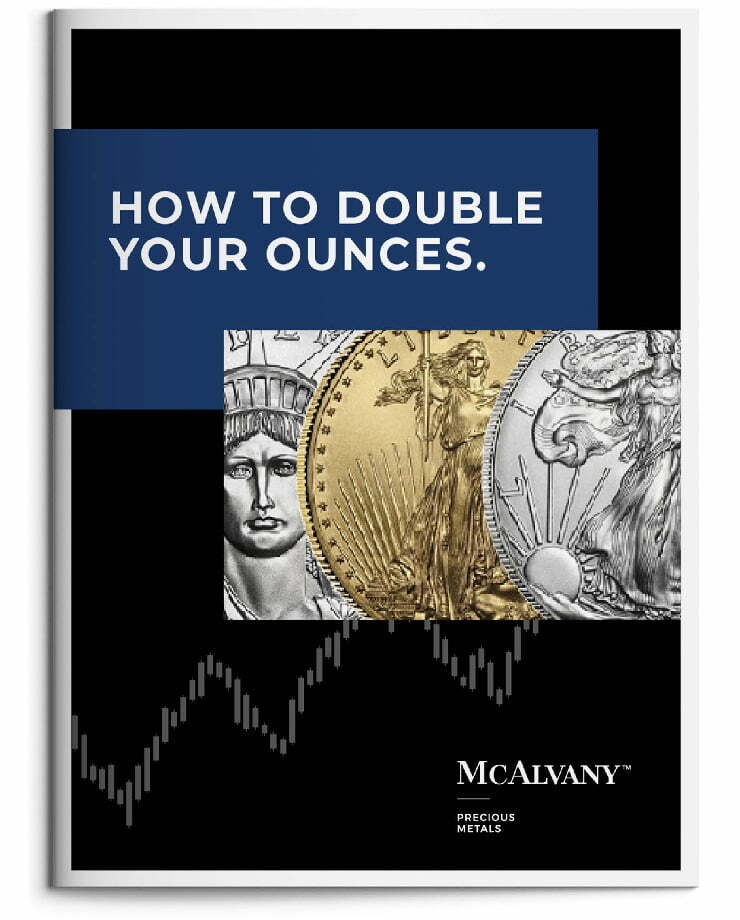The content creators featured below focus this week on the fallout from Trump’s economic policies. Tariffs caused a great deal of volatility in both stocks and bonds, and their postponement settled things down a bit. In the midst of it all, gold gained and held steady.
Looking forward, there is much uncertainty. Rather than try to guess the exact recipe for maximum success, the hosts emphasize preparation for multiple scenarios by anchoring your portfolio with less volatile assets. The king in that regard has always been gold, and still is.
Key Takeaways:
- Gold, the once and future king of value
- Leverage increases power and risk; what does lots of leverage do?
- The miners finally move
- (Relative) war and peace in the markets
The McAlvany Weekly Commentary: Bye Bye Bretton Woods
David and Kevin start off with the big news of the day: tariffs. People who have advocated them for years are now disparaging them because Trump is the one putting them in place. David mentions that equities markets have been due for correction as they’re highly overvalued. That correction, if past is prologue, will end in undervaluation—but that destination is still a long way off. “The journey to undervaluation in equities is long and arduous.” He notes further that, “The post-Rose Garden tariff fallout brought every asset class and every geography on the planet into this grid.” Yet, “to date, we are not in or anywhere close to a recession.” The real action now, he points out, is not in equities, but in bonds. David references an S&P 500 chart, included in the show notes, that demonstrates the historical risk associated with today’s sky-high equity valuations. He then turns to gold and its recent strength, putting it into the context of Gresham’s Law, which states that bad money drives good money out of circulation as people begin to hold onto the good money. David references a recent white paper he wrote (link in the show notes) as a primer on gold’s historic monetary role and the very likely role it will play in our time.
Credit Bubble Bulletin: Normal Deleveraging and Trade Wars
Doug focuses on deleveraging this week, contrasting Treasury Secretary Bessent’s assurances that there was nothing systemic about the week’s action with his own view that, “There was nothing ‘normal’ about this week’s deleveraging—nothing if not systemic.” Doug gives some historical insight into the phenomenon, noting that the most germane comparison is the yen carry trade unwind in August of 2024. Stating that he was skeptical that deleveraging could be carried out as fast as was asserted, he further states that he believes it is still ongoing. He cites Jon Sindreu from the WSJ, “leveraged speculation has proliferated for decades, and it’s reasonable to think in terms of tens of trillions of leverage globally.” Doug continues, “Barring global markets seizing up, deleveraging will be an ongoing challenge over the coming weeks and months. This week was merely a notably rocky start to the process…”
Hard Asset Insights: Right Place, Right Time
“This was a big week at the remarkably busy corner of Wall Street and Main Street,” begins Morgan this week. Citing high volatility, he summarizes: “All told, despite wild swings, stocks finished higher on the week, bonds got crushed, yields spiked, and the dollar crashed.” The notable standout? Gold. Not only did it resist being drawn into the maelstrom, it gained appreciably vis-à-vis the dollar. Its strength was so great that it even drew mining stocks with it. “The undaunted clarity of gold’s bullish move and the market’s sudden embrace of the mining shares culminated in a nearly 20% weekly gain for the HUI gold miner’s index.” Morgan cites the numbers showing strong divestiture from US assets by foreign holders. This, he says, is according to plan. “To be clear, in HAI‘s view, a break away from the post-1971 system that facilitates a redirection of global capital flows in such a way that weakens the dollar, balances trade, and as a result revitalizes the U.S. manufacturing sector, is in fact the goal of Trump administration policy.”
Golden Rule Radio: Navigating a Shaky Market
Miles’s recap has gold down slightly after about a six percent drop intraweek. The same pattern held for the other precious metals and copper—only on a significantly larger scale. In other words, while under heavy downward pressure, gold upheld its historical role and maintained its value while almost everything else lost value. Rob enters the discussion and cites Doug Noland as saying that stocks are just a side show. The star of the show is the 10-year Treasury. Rob continues: “We have to refinance 9.2 trillion dollars’ worth of Treasuries between now and June—just a few months away. I don’t know how we’re going to do it.” In that light, he notes, “we haven’t seen any volatility yet.” He and Miles conclude that liquidity will likely soon become an issue. Miles discusses historical volatility in the S&P 500, noting that we could face the same issue again. Nevertheless, as he says, “we have to live in the world we live in, not the one we think might happen.” Accordingly, he emphasizes dealing with market developments with a steady hand and a plan developed beforehand.















